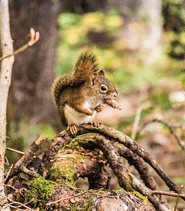By Madeline Strong-Diehl
For as long as I can remember, I have been a tree-loving, tree-hugging kind of gal. At 4’11” tall I had a small body and strong arms that made it easy for me to climb trees. For years, I could follow my two children up any tree as high as they could go. But somewhere along the way I gained some weight and fear of heights, and my tree-climbing days were over. Nevertheless, I have never gotten over my deep reverence for trees. It should be obvious to anyone that they are higher life forms.
Everywhere I have lived, a particular tree has called out to me in friendship. When I first moved to Ann Arbor, more than thirty years ago, I met my “Grandmother Tree” in Wurster Park, located on the Old West Side (and tantalizingly close to Washtenaw Dairy). Prior to that, my Grandmother Trees had been pretty modest, but according to a nearby sign, the tree on top of the hill at Wurster Park is a champion-sized chinkapin oak that’s on the natural registry of historic trees. Ever since we found each other, I have visited my tree often, seeking peace, solace, and advice. There’s no doubt that she’s at least one hundred years old, and a lightning scar down her middle has always helped me remember that we can survive and grow from almost any difficulty in life.
Up until now I would not be so open about the fact that I hug and talk with trees. Fortunately, there is a lot of scientific data coming out that confirms that establishing a close relationship with trees—and even houseplants—can benefit human health in a lot of ways. This is especially important during the time of Covid. We’re probably not going to return to our old ways of socializing with each other indoors anytime soon, however there is a lot of communing—and healing—that we can do outdoors among trees.
A 2001 study sponsored by the Environmental Protection Agency found that the average American spent 93 percent of his or her time indoors—and that was before the coronavirus pandemic caused many people to work from home. Beginning in 2005, researchers had begun to study nature deficit disorder—a condition that can contribute to higher rates of emotional and physical illnesses, including obesity, attention difficulties, and feelings of alienation from nature and from our own bodies.
But luckily, there’s more recent data showing that we can restore our relationship with nature—and ourselves—quite easily and reap the tremendous health benefits of forest bathing just by spending an hour or two meditating among trees—and it’s all free.
The Japanese coined the term and began to study the effects of Shinrin-yoku (forest bathing) in the 1980s. Then, in April 2018, Qing Li, a doctor at Nippon Medical School in Japan, published a book about forest bathing for a general audience after more than twenty-five years of research. According to research by Dr. Li and his colleagues, forest bathing can “release positive hormones in the body,” leaving people less sad, angry, anxious, burnt-out, and depressed. It also enhances the immune system, leads to fewer days of illness, and provides a faster recovery from injury or surgery. It improves heart and lung health and is “known to (increase) focus, concentration, and memory.” It sounds like a miracle cure, but the field of Forest Medicine is growing throughout the world, along with the number of scientists who are studying it.
Related Content: Forest Therapy ~ Embracing Nature, Connecting with Others
So, what is the difference between forest bathing and just taking a walk through the woods? Well, unlike taking a walk from here to there, the main point of forest bathing is to walk randomly, without a destination. Leave your phone and your camera at home and enter the woods mindfully and without any preset expectations. Try to stop listening to the chatter in your head and listen to the forest instead. Look all around you and really notice everything—all living creatures, great and small. Stay in the moment and perhaps meditate on this query: Everything in the forest lives as one. How can I join the One? Most importantly, my own advice—keep your heart open and use all of your senses to search for your Grandmother Tree. She will call out to you, and then you must ask her permission to enter her space; touch her bark; sense the peace and kindness that she is sending out in every direction. When you are both ready, you will both embrace each other, and you’ll feel more grounded to the earth than ever before. You will know, without question, that you belong here. Stay as long as it takes until you’re able to offer yourself radical self-compassion, and remember to say thank you to the forest, and to your Grandmother Tree, when you are done.
Don’t despair if you can’t get to a state or national forest to practice Shinrin-yoku. You can actually practice by befriending just one tree. Ann Arbor earned its place as a “Tree City USA” for good reason, and in your search for a tree to commune with, you’ll be hard-pressed not to find one.
If you can only afford an hour of forest bathing a day or so, pick a tall, stately pine to stand under and look up as far as you can see. Most importantly of all, breathe deeply, in and out, and notice that your heart is beating more and more steadily with each breath. As you continue to focus on each breath, you’ll smell and sense that the air all around you is uncommonly cleansing, fresh, and healthful. As it turns out, that’s not just your imagination. Certain trees like conifers emit oils and compounds to safeguard themselves from microbes and pathogens. These molecules known as Phytoncides are good for our immunity, too.
The other important thing that forest bathing can provide is a sense of confidence and empowerment, and this, too, has been borne out by research. I dread the interminable grey Michigan skies, the constant threat of a polar vortex, and the lake effect snow. I especially dread the social isolation that another year of Covid-19 is likely to bring. However, now that I know about the healing power of forest bathing, and how accessible it is, I am helpless no longer. Dear reader, please try it out and let me know what happens. Most of all, please take good care of yourself and your loved ones. We have a lot of kind and loving trees on our side, and that love is not just random—it’s a fact.





































































































































































































I have dreams that come true. Not all of them, of course, but enough that I now accept this strange unbidden gift as a natural part of who I am. For example, I once dreamed that a dear friend’s daughter was pinned underneath a huge tree that had fallen on her. In the dream, she was alive, but she was unable to move the tree, and she was hurt. The next day I found out this same 16-year-old girl, had been driving too fast on a gravel road, went airborne over a bridge, and hit a telephone pole in her dad’s Dodge Ram. The pole fell, totaling the truck, and trapping her inside. She was banged up, shook up, but alive and safe. Before she had fully recovered, her dad received a bill from the city to replace the telephone pole.